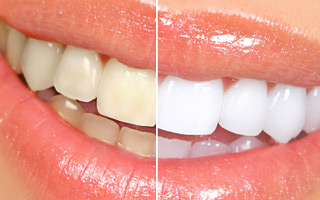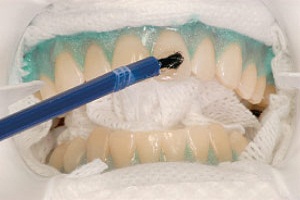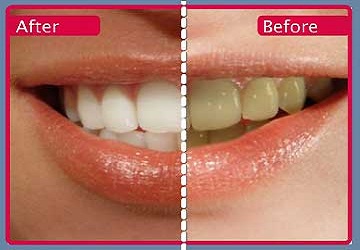Bleaching
Bleaching
Dental bleaching, also known as tooth whitening, is a common procedure in general dentistry. According to the FDA, whitening restores natural tooth color and bleaching whitens beyond the natural color
Gingivitis – Initial inflammation due to irritation, plaque buildup, or poor oral hygiene results in gingivitis. The majority of bleeding from flossing or brushing comes from active gingivitis, due to bacteria depositing just under the gums and irregular or improper hygiene. As part of the healing process, bleeding helps cleanse the area and bring a fresh blood supply to the location of the infection so that healing can occur. However, this condition can quickly progress into periodontal disease and irreversible bone loss if it is not treated quickly. With gingivitis, bleeding will usually only occur during brushing or flossing, when the small area of infection is stimulated.
Periodontal Disease – When gingivitis goes untreated, plaque continues to work its way under the gumlines, causing the pockets (sulcus) to become much deeper. Once bacteria have made its way this far, regular oral hygiene usually cannot remove it because it’s impossible to reach. At this point, the gums detach from the surface of the tooth, and bone structure is also permanently lost. Once moderate to severe bone loss has occurred, teeth become mobile and may actually fall out. Unlike gingivitis, periodontal disease can cause bleeding from stimulants other than oral hygiene. Bleeding may occur during chewing, touching the area, or sporadically on its own.
Aggressive Tooth Brushing – Accidental trauma from aggressive brushing can cause injury to localized areas of gum tissue. Healthy gingiva should not ever bleed during proper brushing or flossing, so if generalized bleeding during brushing is a problem, it’s likely there’s an infection. Using medium to stiff bristled toothbrushes can cause enamel abrasion, tissue trauma, and occasional bleeding if the pressure is too firm. Misaligned TeethMisaligned Teeth
Poor Oral Hygiene – Not removing bacterial plaque on a routine basis will cause an immune response in the body that results in swelling and bleeding. Brushing for too short of a time, and irregular or nonexistent flossing will allow bacteria to secrete byproducts that causes the immune system to target the area where plaque is present. If irregular oral hygiene occurs for several days, bleeding will typically come on fairly easily.
Hormones – Some women find that during hormonal cycles they will experience elevated gum irritation and bleeding. Pregnancy, menopause, or menstrual cycles can bring on gingival bleeding in a small percentage of women. Even women with good oral health may find that their hormone changes affect their gums.
Misaligned Teeth – When teeth are crowded, crooked, have gaps or suffer some other type of misalignment, then they are more difficult to clean around. Misaligned teeth are much more likely to suffer from gum disease, gingivitis, cavities, gum recession, and tartar buildup. There may not be bleeding in any areas of the mouth except those that have misaligned teeth, due to these risk factors.
Iron Deficiency (Anemia) – People that are anemic are more likely to have gums that bleed, even if they floss on a regular basis. This is due to a deficiency of iron, which helps blood platelet formation and restriction of bleeding. When there are not enough platelets in the blood, then bleeding is more evident and harder to stop, even with good oral hygiene. Iron is found in red meats and green leafy vegetables.
Old or Faulty Dental Restorations – Sometimes old fillings can leak, or have open margins that allow bacteria or food to congregate around. This creates chronic irritation to nearby gum tissues. Sometimes even healthy restorations like full coverage crowns will harbor more bacteria due to the small margin around the restoration, requiring more dedicated oral hygiene.



